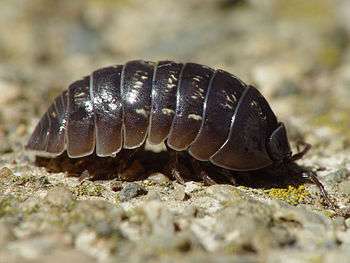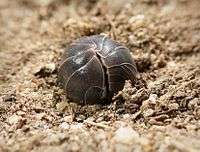Wikijunior:Bugs/Woodlouse
< Wikijunior:Bugs
Woodlice are known by many names including pill bug, armadillo bug, potato bug, and roly-poly. They are crustaceans like crabs, or shrimp, but they live on land. There are more than 3000 known species.
What does it look like?
Woodlice are very small. They have a hard exoskeleton that is made of several sections like an armadillo's shell. They have fourteen legs and are often gray or brown. They have two antenna extending from the head and two small tubes called uropods extending from the back.
Where does it live?
They live in moist environments like forests and gardens all over earth. They are so common that on many parts of the world you cannot turn over a stone lying on the ground without finding them.
What does it eat?
Woodlice eat rotting plants and fungi. A woodlouse gets rid of waste by excreting ammonia through its shell as a gas.

How does it defend itself?
Many species can roll up into a small ball the size of a pill (that's why they're sometimes called "pill bugs") to protect themselves. Some species produce bad smelling chemicals through their uropods as a defense mechanism. Their hard shell also helps to protect them.
What stages of growth does it go through?
After mating, the female carries its eggs in a pouch under its body. These eggs hatch and the young woodlice remain in the pouch until they are big enough to survive on their own. As a woodlouse grows it sheds one half of its shell, then the other. It goes through gradual metamorphosis as the younglings get larger.
What special behavior does it exhibit?
Woodlice need moisture because they breathe through gills. This is why they are often found in damp, dark places, like under rocks and logs. They are usually nocturnal.
How does this bug affect people?
Woodlice are a beneficial garden bug, helping to break down plant-matter and create soil. They are not a serious household pest as they do not spread disease and do not damage wood or structures. They can sometimes damage plants like strawberries.